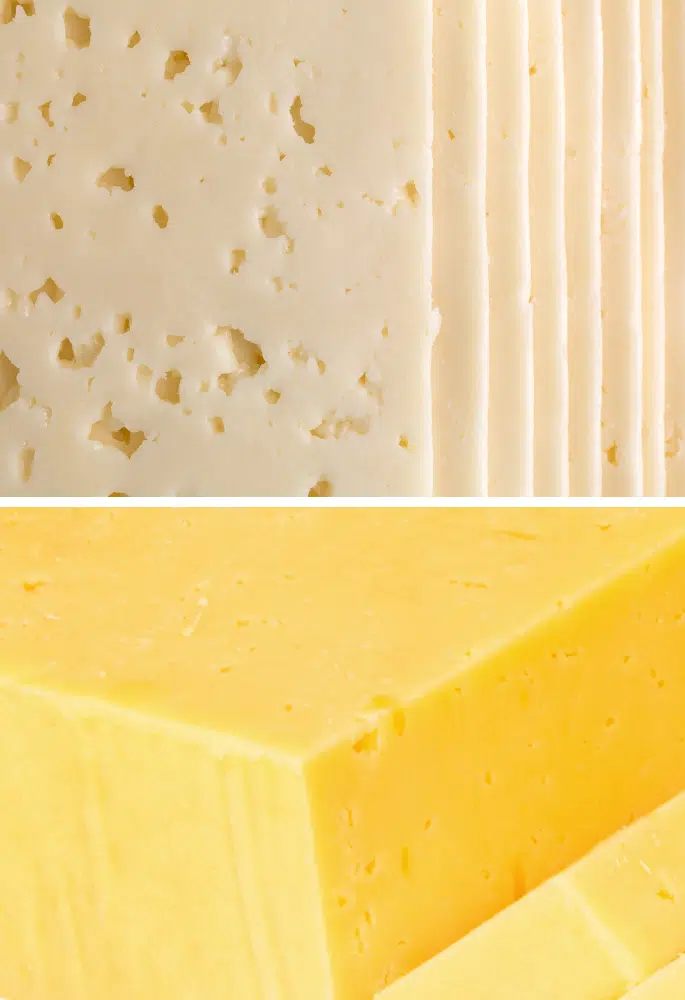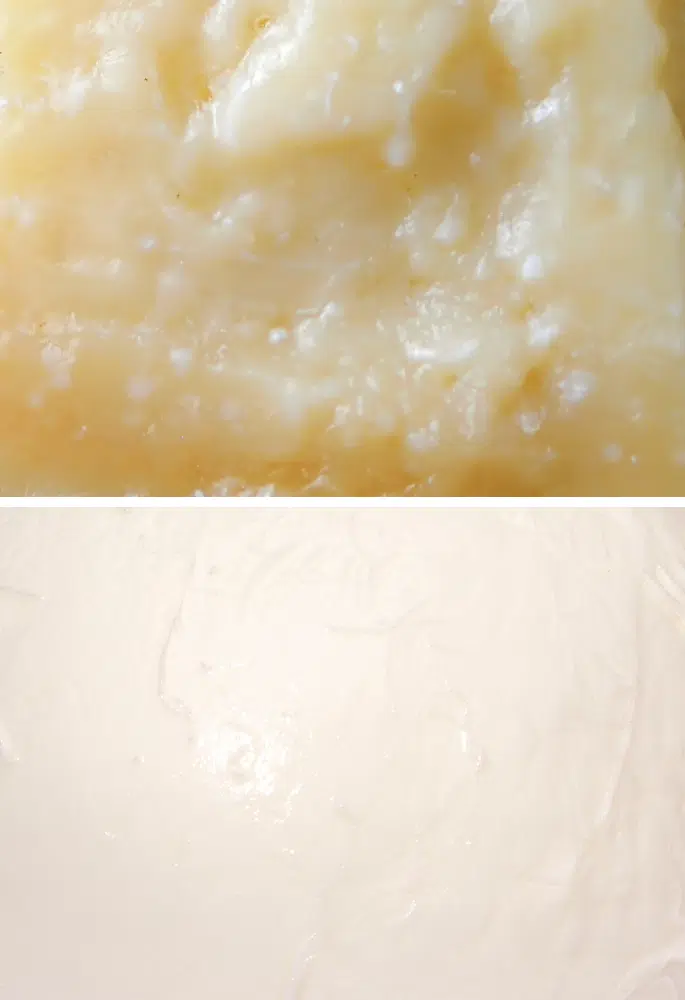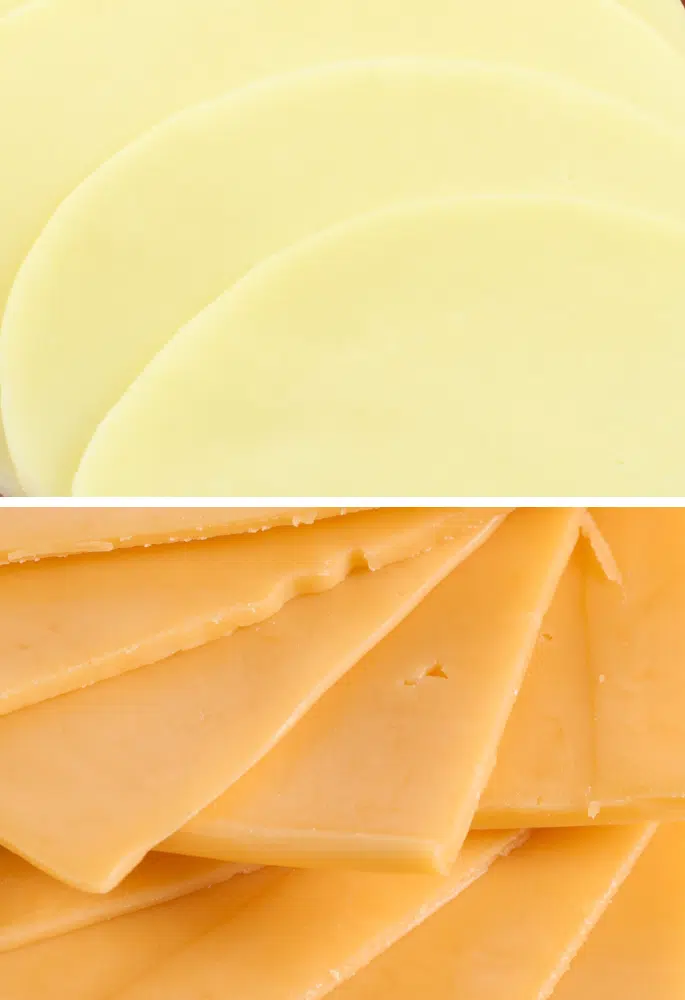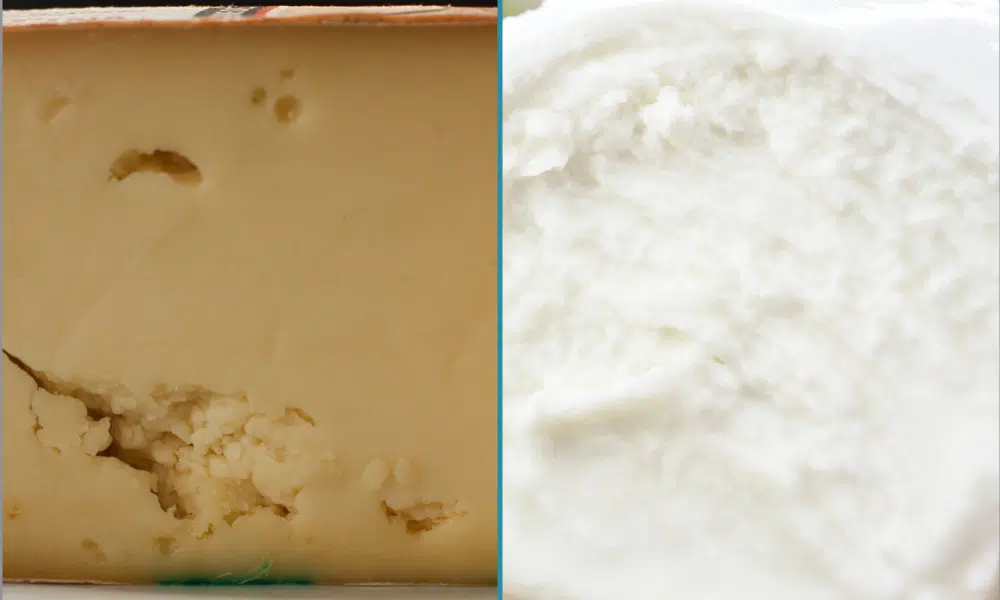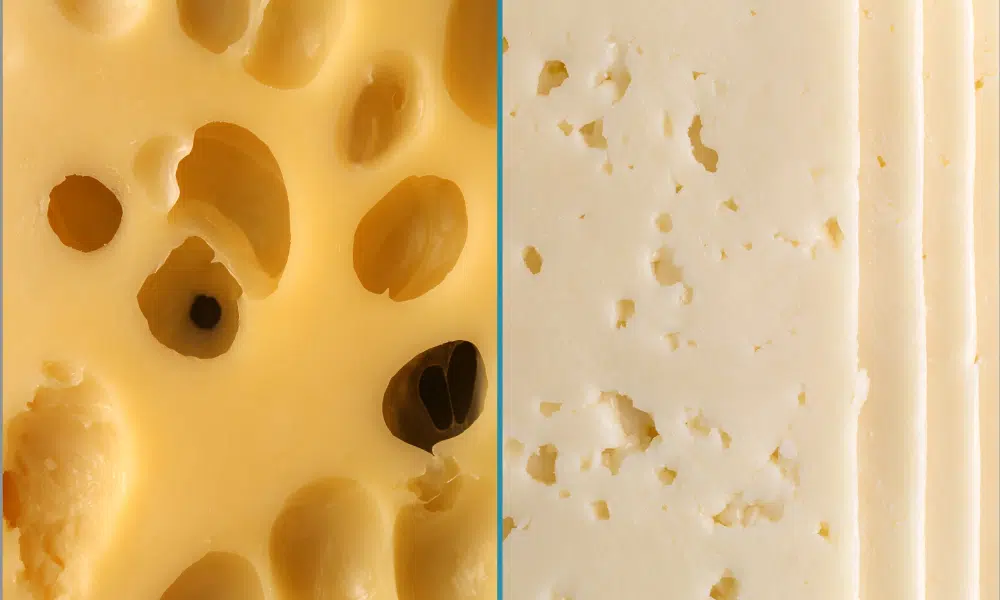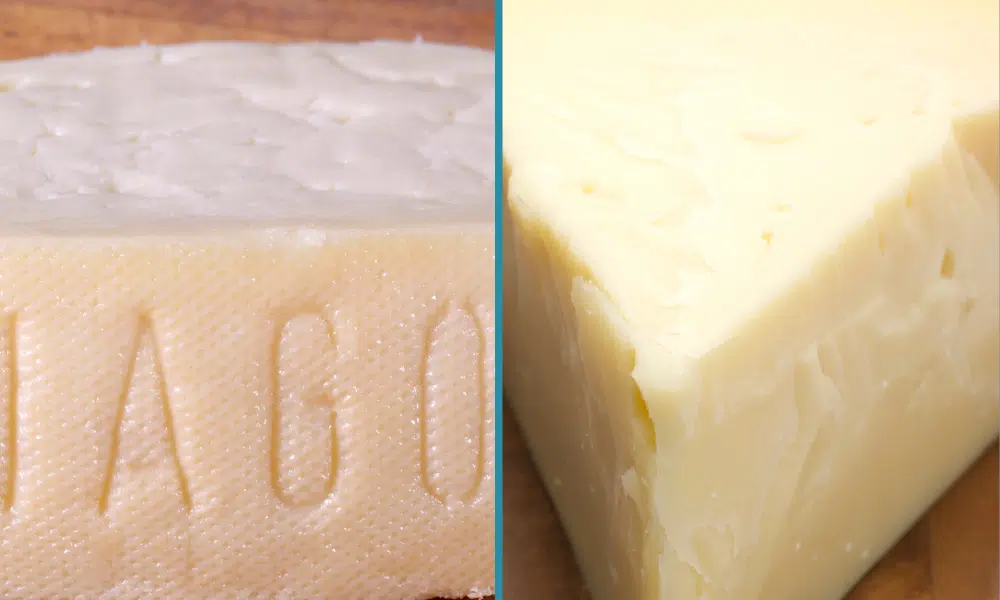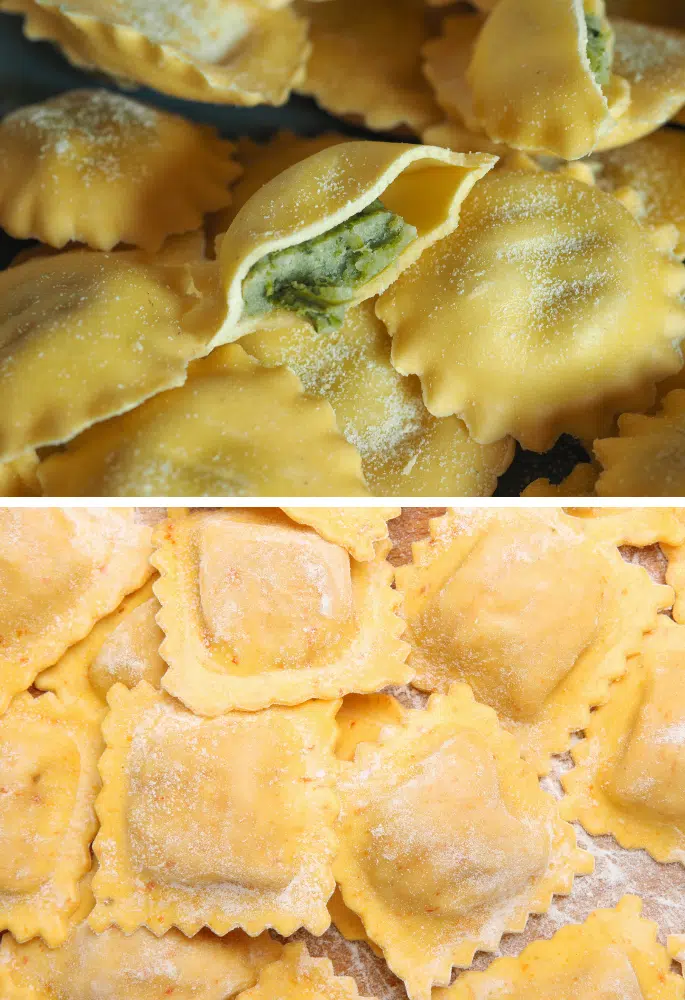The number of cheese varieties available in the supermarket can be pretty overwhelming. But many of them are easy to distinguish. There are, however, some cheeses that appear pretty similar from afar. So, how do cream cheese and cottage cheese compare?
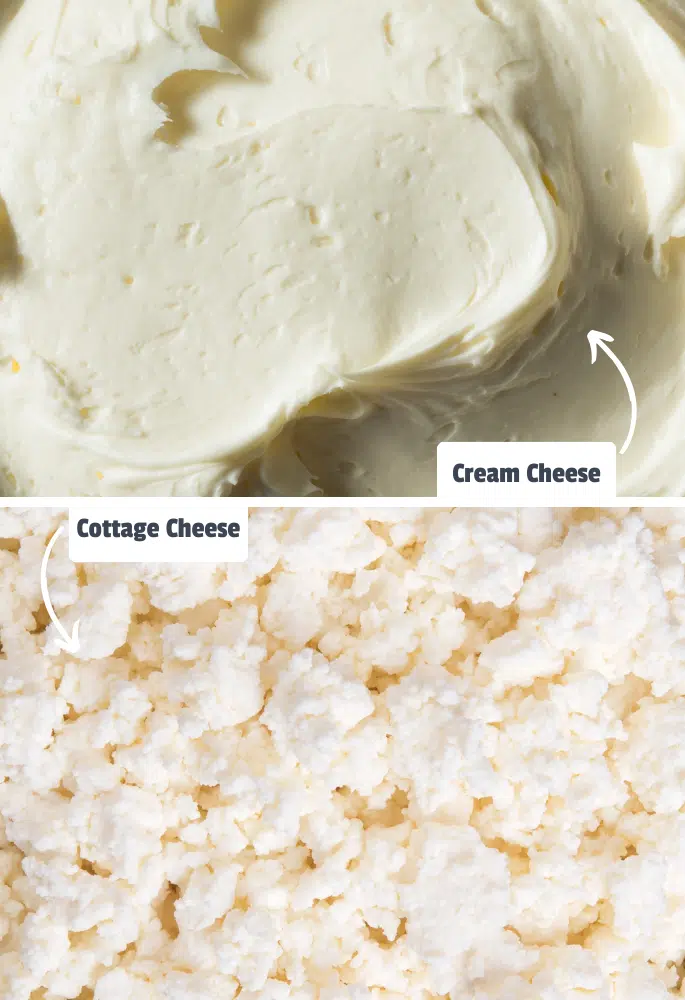
Although they are both fairly light cheese varieties, cream cheese is smooth and rich due to its high-fat content, whereas cottage cheese is lumpy and leaner with curds throughout.
What is Cream Cheese?
Cream cheese is a soft, mild-tasting fresh cheese with a high-fat content. It originated in the United States and has become popular worldwide, particularly in Western cuisine.
It is made by combining milk and cream with an acid, such as lemon juice or vinegar, to coagulate the mixture.
The curds are then heated and stabilized with emulsifiers before being churned and cooled, resulting in a smooth, spreadable cheese with a slightly tangy flavour.
Cream cheese is popular as a spread on bagels, bread, and crackers, and is often flavoured with herbs, spices, or fruit. It’s also a key ingredient in cheesecakes, frostings for carrot and red velvet cakes, dips, and various sauces and desserts.

Its creamy texture and ability to meld with other ingredients make it a versatile staple in both savoury and sweet dishes.
What is Cottage Cheese?
Cottage cheese is a fresh cheese curd product with a mild flavour and a moist but grainy texture. It’s made by curdling pasteurised cow’s milk with an acid or rennet, which causes the milk to separate into curds and whey.
After curdling, the whey is drained but not pressed, so some moisture remains. The curds are then washed to remove lingering acidity, giving cottage cheese a sweet and mild taste.
This cheese is low in fat and high in protein, making it a popular choice for those looking for a healthier dairy option.
Cottage cheese is commonly eaten on its own, seasoned with salt, pepper or spices. It is also used in salads, as a topping for toast and crackers, in lasagnas, and as a replacement for ricotta cheese in various recipes due to its similar texture.
Its origins trace back to European countries, but it has gained significant popularity in North America, particularly in the United States, where it is often associated with diet plans and health-conscious eating habits.
Similarities Between Cream Cheese and Cottage Cheese
Based on the descriptions above, it would be easy to assume that these cheeses really aren’t that similar. But they do share a few characteristics:
- Fresh Cheese Category: Both cream cheese and cottage cheese belong to the fresh cheese category, meaning they are not aged or matured, resulting in a mild flavour profile and a softer texture compared to aged cheeses.
- Dairy Origin: Each is derived from cow’s milk, providing the foundational ingredient for their respective cheese-making processes, which involves curdling milk with some form of acid such as lemon juice, vinegar, or bacterial cultures.
- High Moisture Content: Cream cheese and cottage cheese both have a high moisture content relative to hard, aged cheeses. This moisture contributes to their creamy and soft textures, although cream cheese is smoother, while cottage cheese is more lumpy and moist.
- Versatility in Recipes: Both can be used in various recipes, from breakfast foods to desserts. Cream cheese is favoured for its smoothness in spreads and frostings, whereas cottage cheese is often used for its texture in salads and as a protein-rich addition to meals.
- Nutritional Value: Both provide a good source of protein and essential nutrients such as calcium. However, their fat content differs significantly, with cream cheese having a higher fat percentage and cottage cheese often favoured as a lower-fat option.
- Cultural Significance: Each has a strong presence in American cuisine, with cream cheese being a staple in cheesecakes and bagels and cottage cheese often associated with health-conscious diets and weight management.
- Production Process: The production of both kinds of cheese involves curdling milk and then separating the curds from the whey. However, the specifics of their processes diverge, resulting in their distinct textures and flavours.
Differences Between Cream Cheese and Cottage Cheese
Of course, there’s a reason why these two cheeses are not the same, and that’s because they have many differences, including:
- Texture: Cream cheese has a smooth, rich, and spreadable texture, while cottage cheese is characterised by its distinct small curds and a lumpier, more granular consistency.
- Fat Content: Cream cheese generally has a high-fat content, especially the varieties made with cream, making it much more decadent. In contrast, cottage cheese typically has a lower fat content, with many varieties marketed as low-fat or non-fat.
- Flavour: Cream cheese offers a subtly sweet and tangy flavour, which can be attributed to the cream used in its making. Cottage cheese, while also mildly flavoured, leans more towards a fresh and slightly acidic taste due to its residual whey.
- Usage in Cooking: Cream cheese is widely used as a base for creamy spreads, frostings, and in cheesecakes, owing to its smooth consistency and ability to blend well. Cottage cheese is often used for its texture and protein content in salads, as a topping, or as a healthier filler in dishes like lasagna.
- Manufacturing Process: The process of making cream cheese involves blending cream and milk and adding a stabilising agent, creating a uniform creaminess. Cottage cheese is made by curdling milk, then cutting the curds and cooking them until they form into the characteristic curds and whey, which are not fully blended.
- Cultural Origins: Cream cheese originated in the United States and has become a staple in American and European desserts. Cottage cheese has European origins and is often associated with traditional Eastern European cuisines.
- Nutritional Profile: While both are sources of calcium and protein, cottage cheese typically has fewer calories and more protein per serving compared to cream cheese, which has more saturated fat and calories due to its cream content.
Yes, you can substitute cream cheese for cottage cheese in most recipes, but the result will be richer and creamier. Adjust the quantity and texture as needed since cream cheese is denser and smoother.
Cream Cheese vs Cottage Cheese: Which Wins?
If you had to cast a vote for one or the other, which would it be? All you need to do is select your favourite in our cream cheese vs cottage cheese poll below:
Do You Prefer Cream Cheese or Cottage Cheese?
Acacia may be a freelance writer by day, but they are a food fanatic by night. They are always trying out new recipes or finding different ways to elevate classical dishes. But their biggest culinary aim is to educate others on the basics of the kitchen so that they too can enjoy delicious food.


